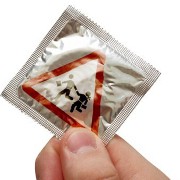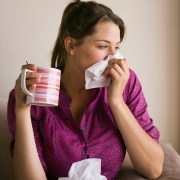 Photo: Getty Images
Photo: Getty Images
I never realized Vaseline was a problem until I read the reference below. Condoms offer effective prevention against HIV/AIDS and other sexually transmitted diseases, when used correctly. But correct use is not as simple as it sounds. Here are some recommendations from Mark Cichocki, RN:
1. Use a generous amount of water-soluble lubricant, widely available in drugstores and sold specifically for use in sexual activity, to prevent breakage of the condom due to friction. Don't use oil-based products intended for other uses, because they weaken the condom and make it more likely to break.
2. Some couples have tried to get extra protection by using two condoms to produce a double layer. This doesn't work. The extra friction may actually increase the risk of condom failure. Female condoms are available (see references) as an alternate to male condoms. Never use both types together, because friction can break both of them.
3. Sheepskin (also called lambskin) condoms are effective at preventing pregnancy, but not HIV. These condoms have micro pores larger than the size of a virus. For people with latex allergies, there are other non-latex options including polyurethane and polyisoprene.
4. Spermicides increase the risk of HIV transmission by irritating the mucous membranes.
5. Oral sex can transmit HIV. One option for protection is the dental dam, developed for use in dental surgery. These are now sold for sexual activity as well.
I found several web sites offering more information on condom use. Much of it is fairly simple, such as check the expiration date, don't reuse the condom, and don't use it if it doesn't unroll properly (use one that does!)
Another point I've always been concerned about is the time between infection and development of the antibodies that produce a positive HIV test. What if something goes wrong? What if the condom breaks? Or what if you're not using condoms because you're in a committed relationship – but then you find out your partner wasn't so committed?
According Reference 1, it takes about six weeks after infection to get a positive HIV test. During this time, the infected person can transmit the virus to others. If you think you've been exposed, you should be tested at six weeks, three months, and six months after potential exposure.
References:
1. Mark Cichocki, RN, Living with HIV: A Patient's Guide, McFarland Publishers, 2009.
2. Female condoms:
http://www.avert.org/female-condom.htm
3. Sheepskin condoms:
http://www.ehow.com/about_4595772_sheepskin-condoms.html
4. Dental dams:
http://www.sexhealth.org/safersex/dentaldam.shtml
5. More information online:
http://www.avert.org/condom.htm
Linda Fugate is a scientist and writer in Austin, Texas. She has a Ph.D. in Physics and an M.S. in Macromolecular Science and Engineering. Her background includes academic and industrial research in materials science. She currently writes song lyrics and health articles.






Add a Comment1 Comments
i have found a website that i think has incorrect information. one article reads that you can use two condoms at one time, but i have always heard the opposite. so, can you or can't you use two condoms at one time? if not, then we need to tell this website to take down their incorrect information. http://www.sexhealth.org/safersex/condom.shtml
April 3, 2011 - 12:39pmThis Comment